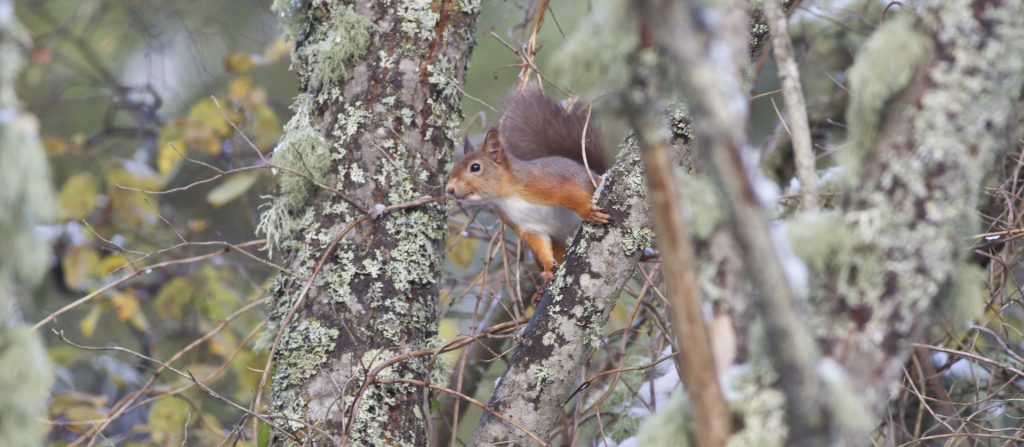Argyll, the Trossachs & Stirling
Successfully defending the Highland Boundary Line to protect north Scotland’s red squirrels through strategic control and monitoring
With vast tree canopies and plentiful food supply, the forests of west Scotland are home to healthy numbers of red squirrels. However, grey squirrels spreading northwards from the Central Belt and westwards from Stirlingshire and Perthshire continue to threaten their survival.
These grey squirrels not only out-compete reds, some also carry the deadly squirrelpox virus. If their spread was allowed to continue, Scotland’s red squirrel stronghold in the southern Highlands would be at serious risk.
The aim in this region is containment of the grey squirrel population to prevent further inroads being made on Scotland’s core red squirrel populations north of the Highland Boundary Line, where lowland Scotland meets the mountainous north.
Working in partnership with the Loch Lomond and The Trossachs National Park, Saving Scotland’s Red Squirrels has set up a network of landowners controlling grey squirrels under Forestry Grant Scheme funding, backed by local monitoring and control volunteers and project staff. This is helping to facilitate ambitious plans to carry out co-ordinated eradication of grey squirrels from the Loch Lomond islands via both trapping and novel rapid response monitoring networks on the islands and shoreline to prevent recolonisation, in collaboration with the National Park and local volunteers.
As we now know squirrelpox is present in some of the Central Lowlands’ grey squirrel populations (with the first death of a red in Dunfermline in April 2024), it’s imperative that grey squirrel densities along the Highland Line are kept to a sufficiently low level, to ensure there is insufficient circulating disease to be readily transmitted to neighbouring red squirrels.
Where red squirrels do succumb locally to the disease, we need to prevent grey squirrels from colonising the vacant habitat, so that it remains available for red squirrels to recolonise once the disease has burnt out.
Evidence from our work in southern Scotland has shown that this approach can be successful in allowing the persistence of red squirrels, despite the presence of the squirrelpox disease (including outbreaks of disease in reds).
Achievements to date
Halting the spread of grey squirrels – In recent years we have seen no further spread of grey squirrels northward or westwards in the National Park area, and have even achieved a retraction of grey squirrels along the shores of Loch Lomond and other areas in the region.
Red squirrel recovery – Thanks to the efforts of volunteers and staff across the region to date, we are beginning to see signs of a recovery in red squirrel populations in areas such as Dumbarton, Falkirk, Mugdock, and Stirling.
Landowner support – We are helping home and landowners to control grey squirrels on their own and voluntarily support the project’s landscape efforts through our trap-loan scheme. We also support landowners to access Forestry Grant Scheme funding to support grey squirrel control.
Volunteer support – We are currently expanding our network of volunteers to help us monitor key incursion routes and track changes in red and grey squirrel numbers across Loch Lomond and the Trossachs National Park and the wider region, as well as measure the impact our work is having in the region. Other volunteers are supporting vital control work through our trap-loan scheme.
Squirrelpox testing – Since 2012 we have carried out annual blood-sampling of grey squirrels across the Central Lowlands to test for squirrelpox antibodies, as part of a national squirrelpox monitoring scheme designed to detect any spread in the disease.
How you can help
- Help us monitor the situation in Argyll, the Trossachs & Stirling by submitting a squirrel sighting to our website
- Take action for red squirrels by joining our trap-loan scheme
- Help protect red squirrels in your local community by signing up as a volunteer dispatcher
- Get involved in citizen science by joining our growing network of monitoring volunteers
- Help prevent the spread of squirrelpox by cleaning your garden feeders regularly with anti-viral solution or get involved with our annual squirrelpox testing efforts
- Send any found dead red squirrels for post mortem to the Royal (Dick) School of Veterinary Studies. Inform your closest member of SSRS staff that you have done so
Volunteering with Saving Scotland’s Red Squirrels is a fantastic way to connect with nature and support your local area’s special native wildlife. Our volunteers are provided with the training and resources they need to participate. If you are interesting in volunteering with the project, please contact your local SSRS staff for more information.
Landowners
Landowners in certain areas can control grey squirrels under Forestry Grant Scheme funding, or join the project’s trap-loan scheme. Woodland owners, meanwhile, can adjust the management of their woods to benefit red squirrels. Please contact your local SSRS or Scottish Forestry staff for more information.
Area Contact
Susie McNaughton
Highland Line Conservation Lead
smcnaughton@scottishwildlifetrust.org.uk

